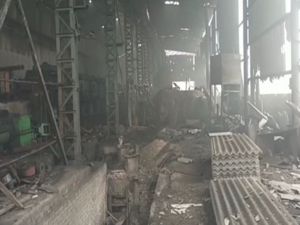
Jagvir Goyal
Collapse of a four-storey building in Solan district a few days back that led to the death of 14 persons, sent shockwaves across the region. Coming at a time when structural engineering and concrete technology are the most advanced, this collapse proves that poor and ill-designed construction is still being carried out by greedy builders. As per news reports, the inadequate size of columns was the main cause of this collapse. Let’s have a look at some important aspects related to design, construction and safety of columns:
RCC framed structures
Building columns constitute part of RCC frames used these days to construct multi-storey buildings. Use of RCC frames is essential from earthquake resistance point of view also. Building columns should only be in RCC as no other material except steel can take the load of a building. Steel or composite columns are rarely used in particular areas and circumstances only.
Size of columns
Size of columns in a building should be decided through proper structural design of the building and not on the basis of any thumb rule. A 9x9 inch size column is too small and may be at the maximum sufficient for a single-storey building only. In a building, the floors transfer all their weight and live load to beams which further transfer it to columns. Columns transfer the whole load of the building to the ground. Therefore, these must be designed professionally. Even for a single-storey building, size of RCC column shouldn’t be less than 9x12 inch.
Horizontal ties or beams
Continuous height of columns without any horizontal RCC beams at regular vertical intervals increases the slenderness ratio of the columns, resulting in reduction of their load-carrying capacity. Ensured that the unsupported height of columns is kept as minimum as possible. Slenderness ratio shall depend on the unsupported height and dimension of column. Lesser it is, the better is the strength of a column.
Steel reinforcement
Diameter of steel bars provided in RCC columns plays a vital role in determining their load carrying capacity. In no case, should vertical bars of diameter less than 12 mm be used. Use of 16 mm or 20 mm diameter or even 25 mm diameter is still preferable depending upon the load on the column. These vertical bars need to be further tied and kept in designed place by using lateral ties of 8 mm or 10 mm diameter at regular vertical intervals. IS Codes also prescribe minimum area of steel reinforcement to be provided in the column section area. This criteria should also be fulfilled.
Adequate cover
It is important to provide adequate concrete cover to steel bars provided in a column. This concrete cover keeps the steel well hidden it and saves it from rusting and corrosion. Rusting of steel bars, if exposed, may ultimately lead to collapse of the columns over the years. The clear cover of concrete beyond the outer edge of lateral ties holding the vertical bars in position shouldn’t be less than 25 mm all around the column throughout the height of column. If cover is not uniformly provided, steel shall be attacked at the point where the concrete cover is minimum.
Future additions
It is common practice to add more storeys to an existing building to reap more profit. The beams and columns are examined at a glance, declared ok and a new floor is added. This is a dangerous practice. The simplest way is to design the columns by keeping future additions in mind. The structural engineer will consider the load of future additions also and design the columns accordingly.
Concrete grade
Columns should be built by using properly designed and controlled concrete and not with uncontrolled mixes of 1:2:4 or 1:1 ½ : 3 etc. M15 grade of concrete shouldn’t be used in columns. Minimum grade of concrete for columns should be M20. Higher grades are preferred.
Right footing
It is very important to provide adequately sized and well-designed RCC footing for columns to safely transfer all the load to the ground without settlement of the footing. Footing should be provided at adequate depth below ground level and rested on firm soil. The structural engineer will design how the vertical steel bars of the column enter the footing to create a fully integrated joint between the footing and the column and will also check the joint of column and footing for punching shear and other factors to make it safe against cracks.
Cut entry of water
There should be no scope for water leakage around the building foundation from where the water can enter the footing of the columns.
Structural appraisal
Engage a structural design engineer to design all RCC components of a building and get construction supervision done from a civil engineer for proper quality of materials, proper workmanship and execution of work as per structural drawings. Later on get structural appraisal from a qualified engineer.


























